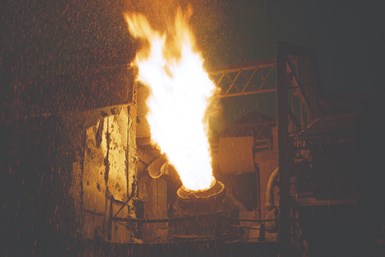Unavailability of Bessemer Steels
Bessemer Steel is no longer produced. So why isn’t it produced and what do you do when the print says “Bessemer steel”?
A scene in a steel mill, Republic Steel, Youngstown, Ohio. Molten iron is blown in an Eastern Bessemer converter to change it to steel for war essentials. Photo Credit: Alfred T. Palmer, 1941, Library of Congress
From time to time, our customers ask our shops to quote on Bessemer steel for legacy military (MIL STD, MIL Spec) and Federal (Fed STD, FED Spec) applications. Typically, the requests are for B-1113 — a Bessemer Steel. The B- prefix indicates that the steel grade is produced by the Basic Bessemer process. Higher sulfur Bessemer steels were developed to produce consistently higher machinability performance which is critical for high-speed production of large quantities of identical parts using screw machines.
The Bessemer Process
The Bessemer Process was a pneumatic (air blown) method of converting blast furnace iron to steel. It came into use in the late 1800s — first in England, then in the United States.
There were two primary Bessemer processes, depending on the type of refractories available. The original process was acid — linings for the converters were lined with ordinary clay. The successor process was called the Basic process. The refractories used for this Basic process were limestone/dolomite. The Basic process became the primary process commercially due to its longer life in the tuyeres (providing the air blast) and the vessel bottom. It also provided for an improved “control” of phosphorus and removal of impurities in its higher volume slag.
The acid process was discontinued early in the 20th century, and the Basic Bessemer process fell into decline following WWII. It was replaced by production from Open Hearth, Basic Oxygen and Electric Furnace processes.
Replacement Grades
One feature of the Bessemer process was its inability to remove phosphorus from iron, so typical Bessemer analyses included a 0.07-0.12 weight percent phosphorus. This phosphorus helps to embrittle the chip in machining, which is why the replacement grades for the Bessemer B11XX steels specify a range of phosphorus. The replacement steels were the 12XX steels, and today we find that 1215 and 12L14 are the heirs to the Bessemer B11XX series steel. The 12XX steels are called resulfurized (added sulfur) and rephosphorized (added phosphorus) to achieve the same chip-forming machining response as the original high phosphorus, resulfurized Bessemer steels.
The Bessemer steels were also saturated with atmospheric nitrogen as they were blown with atmospheric air. This also helped to embrittle the chip. Accordingly, the 12XX replacement grades can be ordered as nonre-nitrogenized (no deliberate addition of nitrogen). Or they can be ordered as renitrogenized — the higher nitrogen further embrittling the chip. Caution should be used when a precision machined part will have subsequent cold work after machining — staking, swaging, crimping, planishing and more — as the embrittling effect of the nitrogen (in combination with the phosphorus) that aids chip separation also impedes cold metal movement in the machined part.
My information confirms that the Bessemer (B-series) steels fell out of favor shortly after World War II, with perhaps one eastern J&L mill producing Bessemer screw stock at the end of the 1950s.
12L14 and 1215 are the currently available replacements for the Bessemer resulfurized grades. Their rephosphorized, resulfurized and possibly renitrogenized composition was developed to make them a drop-in replacement for the no longer available Bessemer screw stocks.
The Bottom Line
Here’s the bottom line — no Bessemer steel is produced today. None is available in inventory.
The commercially available 1215 and 12L14 grades of steel have been used as replacements/substitutes for various Bessemer resulfurized grades on obsolete federal government prints throughout my career as laboratory supervisor, plant metallurgist and director of quality, technology and development director at USS, Bliss & Laughlin Steel, Bar Technologies, Republic Steel and PMPA. Both 12L14 and 1215 will give comparable properties and performance compared to B1113.
Read More Articles from PMPA:
- Strategy and Teamwork: Better Together
- Craftsman Cribsheet No. 110: PMPA Speaking of Precision Podcasts — Safety and Regulatory
About the Author
Miles Free III
Miles Free III is the PMPA Director of Industry Affairs with over 40 years of experience in the areas of manufacturing, quality, and steelmaking. He helps answer “How?, “With what?” and “Really?” Miles’ blog is at pmpaspeakingofprecision.com; email – mfree@pmpa.org; website – pmpa.org
Related Content
Do You Have a Quoting Process?
The only way to have repeatable results is to have a process.
Read MoreCraftsman Cribsheet No. 119: Defeating the Hanging Cross-Hole Burr
Deburring is a tedious task that is better left to machines.
Read MoreA No/Low-Cost Solution to Employee Retention
Studies show a little employee recognition goes a long way. Here are the 5Ws to consider for success.
Read MoreOnshoring Weather Report: Strong Tailwinds!
Onshoring, reshoring, nearshoring: these terms are showing up with increasing frequency in the news and online. But is there evidence that these are real?
Read MoreRead Next
Do You Have Single Points of Failure?
Plans need to be in place before a catastrophic event occurs.
Read MoreA Tooling Workshop Worth a Visit
Marubeni Citizen-Cincom’s tooling and accessory workshop offers a chance to learn more about ancillary devices that can boost machining efficiency and capability.
Read More5 Aspects of PMTS I Appreciate
The three-day edition of the 2025 Precision Machining Technology Show kicks off at the start of April. I’ll be there, and here are some reasons why.
Read More























